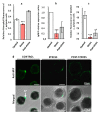Atypical Membrane-Anchored Cytokine MIF in a Marine Dinoflagellate
- PMID: 32825358
- PMCID: PMC7565538
- DOI: 10.3390/microorganisms8091263
Atypical Membrane-Anchored Cytokine MIF in a Marine Dinoflagellate
Abstract
Macrophage Migration Inhibitory Factors (MIF) are pivotal cytokines/chemokines for vertebrate immune systems. MIFs are typically soluble single-domain proteins that are conserved across plant, fungal, protist, and metazoan kingdoms, but their functions have not been determined in most phylogenetic groups. Here, we describe an atypical multidomain MIF protein. The marine dinoflagellate Lingulodinium polyedra produces a transmembrane protein with an extra-cytoplasmic MIF domain, which localizes to cell-wall-associated membranes and vesicular bodies. This protein is also present in the membranes of extracellular vesicles accumulating at the secretory pores of the cells. Upon exposure to biotic stress, L. polyedra exhibits reduced expression of the MIF gene and reduced abundance of the surface-associated protein. The presence of LpMIF in the membranes of secreted extracellular vesicles evokes the fascinating possibility that LpMIF may participate in intercellular communication and/or interactions between free-living organisms in multispecies planktonic communities.
Keywords: Lingulodinium polyedra; MIF; dinoflagellate; secretion; stress response; transmembrane protein.
Conflict of interest statement
The authors declare no conflict of interest.
Figures



References
-
- Günther S., Fagone P., Jalce G., Atanasov A.G., Guignabert C., Nicoletti F. Role of MIF and D-DT in immune-inflammatory, autoimmune, and chronic respiratory diseases: From pathogenic factors to therapeutic targets. Drug Discov. Today. 2019;24:428–439. doi: 10.1016/j.drudis.2018.11.003. - DOI - PubMed
Grants and funding
LinkOut - more resources
Full Text Sources
Miscellaneous

